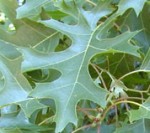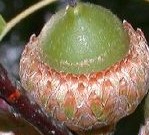 Scarlet oak is a long-lived deciduous tree belong to the oak family, Fagaceae, that also includes beeches and chestnuts. It is native to central and Eastern US where it grows well in forests or woodlands with sandy, acidic, medium dry soil. The upright open growing tree has wide spreading branches growing from a quickly tapering trunk that has gray to black ridged, scaly bark. The alternate leaves are bright red when they emerge in spring and turn bright green in the summer before turning scarlet in the fall. They are hairless, three to seven inches long by two to four inches wide, and are deeply cut with seven (rarely nine) pointed bristle tipped lobes. Non-showy yellowish-green male and female flowers appear in spring with the leaves on the same tree. The male flowers are in pendulous catkins while the female flowers are solitary or clusters. In the fall the female flowers produce ½ -1 inch long reddish-brown ovoid acorns with deep cups covering about one third of the nut. Scarlet oak is considered a good shade tree and an attractive ornamental for both its fall coloration and the winter interest created by the design of the branches. It is difficult to transplant and not readily available in the nursery trade.
Scarlet oak is a long-lived deciduous tree belong to the oak family, Fagaceae, that also includes beeches and chestnuts. It is native to central and Eastern US where it grows well in forests or woodlands with sandy, acidic, medium dry soil. The upright open growing tree has wide spreading branches growing from a quickly tapering trunk that has gray to black ridged, scaly bark. The alternate leaves are bright red when they emerge in spring and turn bright green in the summer before turning scarlet in the fall. They are hairless, three to seven inches long by two to four inches wide, and are deeply cut with seven (rarely nine) pointed bristle tipped lobes. Non-showy yellowish-green male and female flowers appear in spring with the leaves on the same tree. The male flowers are in pendulous catkins while the female flowers are solitary or clusters. In the fall the female flowers produce ½ -1 inch long reddish-brown ovoid acorns with deep cups covering about one third of the nut. Scarlet oak is considered a good shade tree and an attractive ornamental for both its fall coloration and the winter interest created by the design of the branches. It is difficult to transplant and not readily available in the nursery trade.
 Type: Deciduous tree
Type: Deciduous tree
Outstanding Feature: Autumn coloration, winter design
Form: Loosely pyramidal in youth maturing to oval with irregular canopy
Growth Rate: Rapid
Bloom: Non-showy male flowers in catkins, and female flowers singly or in clusters, in spring when leaves emerge
Size: 50-80’ H x 40-65’ W
Light: Full sun
Soil: Average, medium dry, well-drained
Hardiness: Zones 4-9
Care: Prune in winter when young to establish good framework
Pests and Diseases: Generally healthy but susceptible to scale, caterpillars, leaf spot, anthracnose, canker, mildew, rust, wilts, rots, and galls.